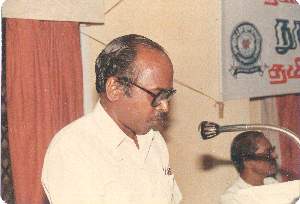

Home | Biodata | Biography | Photo Gallery | Publications | Tributes
Tamil Studies

 |

Home | Biodata | Biography | Photo Gallery | Publications | Tributes Tamil Studies |
 |
Introduction
Even though computers are basically counting devices they can also perform a number of sophisticated operations. Today the computer is used as a powerful tool not only by scientists and engineers but also by social scientists and archaeologists . During the recent past scholars have made use of the computer in the area of epigraphy in India and abroad. First the computer has been used in studying the Indus script using techniques that are basically statistical in nature. Secondly the computer has been used in photocomposing. Thirdly it has been used for dating medieval Tamil inscriptions using numerical methods. Fourthly the computer has been used for image enhancement. Fifthly it has been used for recognizing letters of the Brahmi script from Asokan inscriptions and the work is still in progress. Finally we attempt in this paper to use the computer for recognizing characters of the Tamil script of the period of the Rajendra Chola I of 11 th century A.D.
Statistical Methods
The work of Russian and Finnish scholars in applying statistical techniques with the aid of computers for the study of the Harappan script has been reported in the Journal of Tamil Studies. Mr I. Mahadevan has also made use of computers in Madras and in Bombay for his study of the Indus or Harappan script. Using computers he was able to analyse a large quantity of data and test different hypotheses. A group of Japanese scholars have also been making use of computers in analysing inscriptions. They use direct methods of counting the frequency of certain words that occur in the inscriptions of the different periods. The methods used are primarily data processing methods.
Computer-assisted Photo-composing
The concordance of the Indus script prepared by I. Mahadevan was printed with the assistance of a computer. This kind of computer technology is new to India and the National Centre for Software Development and Computing Techniques had made the preparation and printing of the concordance possible.
Computer Methods of Dating
The authors of this paper have demonstrated the possibility of using computers for dating medieval Tamil inscriptions .1 The techniques used are derived from the area of Computer Science known as Pattern Recognition. Starting with a set of firmly dated inscriptions we were able to date an inscription of unknown authorship. Work is still progressing in this area and we are trying to improve the results.
Computer and Image Enhancement
For recovering good quality pictures from satellite photographs image enhancement techniques are used. One of us (Siromoney) was able to make use of what are known as line detectors for getting clearer pictures of estampages .2 Siromoney used a Pallava Grantha inscription from Kanchipuram for this experiment in 1974 at the Picture Processing Laboratory of the University of Maryland, College Park, in the United States of America.
Computer Recognition of Ancient Scripts
Normally when a computer is used for data processing, data would be fed into the computer through punched data cards, magnetic tapes or through a teleprinter or a CRT terminal. In contrast to this, in the recognition problem we try to make a computer recognize a letter and to distinguish it from other letters. As in the image enhancement methods, special equipment is necessary for converting the picture into some form which can be stored in a computer. Since such devices are not available in Madras, at the moment, we have digitized the data manually.
We are asking ourselves the question whether in the foreseeable future, a computer can be fed directly with photographs of inscriptions and asked to give reading.
We have developed methods by which machine printed Brahmi characters can be recognized3 That is each character must occur only in one form as in letters occurring in print using one style and size. To recognize Brahmi from an inscription it is more difficult and work is in progress.
Computer Recognition of Tamil Script
We have successfully demonstrated that machine-printed Tamil letters can be recognized by the computer .4 In this paper we extend it to the Chola script. Using the methods already developed it is possible to recognize machine-printed Chola characters. What we are attempting is to recognize hand-printed letters of a Chola inscription. Work is still in progress.
REFERENCES
1. Gift Siromoney, M. Chandrasekaran and R. Chandrasekaran, (1977), Computer Methods of dating medieval Tamil inscriptions, STAT
26/77, Department of Statistics, Madras Christian College.
2. Gift Siromoney, (1975), Computer techniques of image enhancement in the study of a Pallava Grantha
inscription, Studies in Indian Epigraphy, Vol.2, pp.55-58.
3. Gift Siromoney, R. Chandrasekaran and M. Chandrasekaran, (1978) ,, Computer recognition of an ancient common Indian script, STAT/36/78, Department of Statistics, Madras Christian College, Proceedings of the symposium on Linguistic Implications of Computer Based Information Systems
.
4. Gift Siromoney, R. Chandrasekaran and M. Chandrasekaran, (1978), Computer recognition of printed Tamil Characters, Pattern Recognition, Vol. 10, pp. 243-247.